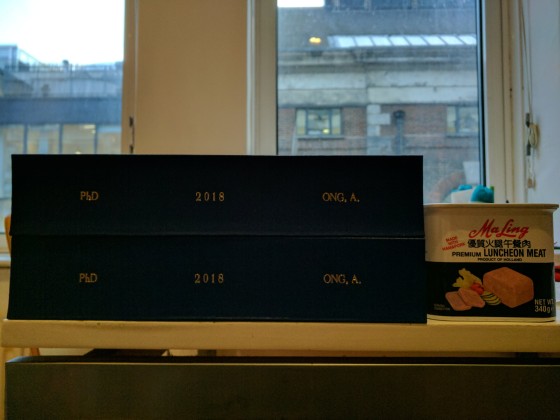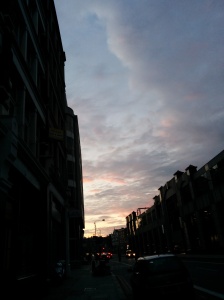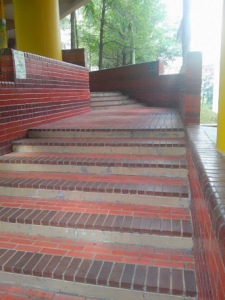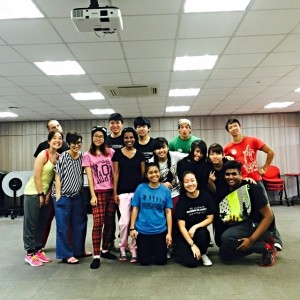On 31 March 2016 there was a Townhall meeting organised to discuss the artistic direction of The Substation.
The Substation’s tagline is ‘A Home for the Arts’ (The Substation 2016).
It is difficult to be so far from ‘home’, not being able to fully participate in discussions about its future. So these are some initial thoughts, in lieu of being present, being there. Being ‘home’.
11 December 2015: The Substation’s new artistic director, Alan Oei, announces plans to phase out venue hire at The Substation and major renovations of the space so that it will be able to house two artists, for two months residencies throughout the year.
January 2016: The Substation announces the end of its dedicated film programme Moving Images, as well as First Takes, a platform where budding filmmakers presented new films to their first audience.
February 2016: Punk gig organiser Shaiful Risan laments the closure of well-managed, independent venues for ‘noisy people’ (Risan in Atmos 2016). Artist Godwin Koay points out that ‘we never owned this space’, a testament to ‘a failure of its many users to stand against pressures coming from state driven trajectories of growth’ (Koay 2016).
Where are the places for practices that challenge our understanding of what ‘art’ or ‘performance’ is in Singapore? Are these places negotiated, or claimed/appropriated? Is a ‘Home for the Arts’ built or allocated?
I remember the Substation, including its garden and the S11 nearby, as a place that supported a diversity of local artists who were pushing the boundaries of disciplines in their effort to express themselves. I remember the garden as the site of the first SRT Young Company performance directed by Wendy Ng in 1997. As an untested actress feeling my way around the theatre scene in Singapore, the garden was a place for exploration. The beautiful trees offered their branches for mischievous climbing (though you had to be prepared to get bitten by ants) and its roots offered a place to curl up in when you needed some solace (mosquitoes notwithstanding). I would return many times to The Substation theatre (Fall of the House of Usher (1999); Saturday Night (1998); Performing Words (2003)), its garden (Peace Concert (2003); a monologue from Caryl Churchill’s Cloud 9 (1999)) such that when I started to understand what my practice might be, The Substation seemed like the best place for testing that practice through performances like Postcards from Persephone (2000), projects like Digital Compassion ‘02 (2002) and ‘street x art’ experiments like Pulp (2003).
Over and above that infrastructural support provided by The Substation, was the ecosystem created by the many Substation artists, and practitioners, who took the time to challenge young practitioners like me, always informally, at places like S11. Lee Weng Choy once said in an interview,
Art is a public conversation. Art is about having a public, no matter how small that public is. That’s been at the core of what The Substation does: it allows for individualism and it recognizes that individualism has to have its public, and its community. We’ve always been doing that; it’s a role that hasn’t lost any relevance or urgency (Lee in Martin 2013).
Are these places for untested artists disappearing? Is this what made The Substation a ‘home’? And if a home for provocative expression is something that many artists seek to defend, what are the shared responsibilities of nurturing an environment for the arts that enables this expression?
At the same time, I am aware of the trappings of comfort, familiarity, belonging – concepts that one might associate with the word ‘home’. Acceptance that can turn into tacit conformism. At Space, Spaces, And Spacing, a Substation Conference in 1995, T. Sasitharan cautioned against subscribing to the narratives of smallness that limit our imagination. He also said that ‘the worst thing about this lie…tied to the story of smallness, is the notion that space here for the arts too is necessarily small and limited. And we have bought this without subsequently learning the strategies of reclamation’ (Sasitharan [1995] 1996: 55). This narrative of smallness is an idea that feels quite relevant today, in light of the Townhall meeting, even as Sasitharan reminds us that ‘culture and the arts are hardy, desert flowers, quite capable of blooming if they have to in barren, hostile landscapes’ (Ibid.).
Is the Substation the only place where untested artists who have yet to build a body of work can enter into meaningful conversations with experienced arts administrators and discover collaborative ways of making with more established artists/practitioners? Are there other places where one might meet with more established artists who are still exploring the limits of their practice and in doing so, be challenged to deepen their own practice? And if not, should this not prompt us who care about the growth of the arts community in Singapore to create more opportunities for emerging artists to do so? Perhaps, like bell hooks once said ‘I had to leave that space I called home to move beyond boundaries, yet I needed also to return there….At times, home is nowhere. At times, one knows only extreme estrangement and alienation. Then home is no longer just one place. It is locations.’ (hooks 1990: 148). Home is a place that is made and often, it is through struggle that one secures some semblance of the environmental conditions that one associates with home.
So even as I recognise that the Substation was ‘home’ in many ways for me, I’ve gleaned (through various conversations with young artists, certainly not a critical mass) that this is what seems to be lacking in Singapore now. There’s need to create more places for young artists to engage with, and possibly collaborate with, those who are established and who continue to grow their practice in the arts community. The Substation should not be the only place where this is possible. It should be one of many and it is up to us to make it so.
Finally, some thoughts and responses to the FAQs and the information releases that have been put out over the last month:
#1 The Substation hasn’t changed. Everything has!
A Home for Making, Not Showing
6. The Sub has become a home for showing – exhibitions, programmes, screenings, etc. It is providing content rather than artistic vision…
7. The Sub should refocus on how to fulfill Kuo’s vision of making – putting process, practice, thought and experimentation above the final product – in the complex landscape.
As The Substation moves towards research-oriented (and process-focussed) Artists-in-Residencies (AiR), I wonder if there might be a false binary drawn here between ‘making’ and ‘showing’ in performance/practice-research. As an applied theatre practitioner and researcher my experiments often take the form of workshops that inform the practice that I’m developing. The workshop is a form of sharing (‘showing’) what my practice is, even though it is still a practice-in-the-making. And I gather, from what I’ve heard/seen of my colleagues who are engaged in practice-as-research that some form of showing (conference presentations, work-in-progress sharing sessions) is an important part of making for them. In Central School of Speech and Drama, there is also an annual showcase for Practice-as-Research PhD candidates called Collisions. Collisions feels like a work-in-progress showing with the valuable opportunity of opening up the research process thus far to the audience and inviting perspectives that very often are a useful source of ideas when one gets stuck. So while it might be useful to highlight to funders that the AiR will not be outcome-oriented, perhaps it is also worth keeping in mind that making and showing are not exclusive, and can occur simultaneously, organically expressing itself as mixtures of both in performance/practice research.
#2 Mar 4: Artists have real stakes
Reading through the transcripts of the earliest Substation Conferences (Lee 1995; Lee 1996; Kwok et al. 1999), the Substation’s 25th anniversary book (Wong 2015), and the two documents on The Substation’s website: ‘The History of The Substation’ (Wong [no date]) and ‘The Role of The Substation in Singapore’s Arts Scene’ (Lee [no date]), I get the impression that The Substation, and many of its Associate Artists, have always been conscious of the ways in which their practice has ‘real stakes’. This was not just an awareness and aspiration regarding the role of the arts in Singapore. They were also very conscious of how the global and the local are fluid, constantly changing yet mutually constituted, not just within the arts, but also on many intersecting social and political issues of concern.
The Candlelight Concert for Peace at the Substation in 2003 might perhaps be cited as one such example. Even though there were those, including former journalist Chua Lee Hoong, who dismissed the event as a ‘postured defiance of societal norms’ and stated that she would rather donate the money saved on candles to Mercy Relief (Chua 2003), given the restrictions placed upon protests in Singapore (then?), such artistic events made visible the ‘we’ who opposed the pre-emptive war in Iraq.
FAQs: ‘The true measure of when it’s successful again is when its independent voice can resonate at a national level. For us to do that, it also means that it cannot just be the arts community supporting The Sub. It needs a larger traction of middle class Singaporeans so that for instance, when we have disagreements with the State, it cannot arbitrarily pressure us. But that is not to say that we are deliberate troublemakers, but that we want to be able to talk about difficult things in serious ways using the arts – to discuss about issues in measured and balanced ways’ (Oei 2016).
In desiring to cultivate a certain middle class profile of supporters for The Substation, there seems to be an assumption of some majority consensus in opinion amongst middle-income individuals. But this seems misguided, particularly when people often take positions on issues that concern a loss of place (like MacRitchie) based on personal values that may not be related to social or cultural capital that relates so neatly to income levels.
The ‘we’ present at the Candlelight Concert for Peace (2003) was constituted by people of all income levels, mostly across the arts community but there were also those who would not consider themselves artists. They felt it was important to be there, to visibly form the ‘we’ who did not support the war. To borrow from Judith Butler’s speech at Occupy Wall Street, where every line was repeated (in italics below) by the crowd so that all gathered could hear the message:
We’re standing here together making democracy
We’re standing here together making democracy
Enacting the phrase
Enacting the phrase
‘We the people’
‘We the people’ (Butler et al. 2011)
This was not a ‘we’ formed by consensus. This was a ‘we’ that had many different perspectives on alternative economic systems and what ‘fair’ might be. But that pluralism is representative of ‘we the people’.
And as The Substation strives towards making ‘its independent voice resonate at a national level’, I would argue that it is important to remember that the ‘we’ emerges from people who care enough, regardless of ‘class’. Courting influence should not be undertaken at the expense of Substation’s credibility (built up over the last 25 years through its support of diversity) in representing that collection of alternative voices regardless of how niche they might be.
And losing that credibility would be a shame because, I suggest, that representing the complex pluralism of the ‘we’ and persuading people to care enough, is precisely where the influence of the arts lies.
Returning to the Townhall meeting: I couldn’t be there, to physically form the ‘we’ concerned about matters of ‘home’. So this is a virtual postcard that hopefully contributes a little to that conversation. And if all this was already covered, already discussed, please do share so that those who cannot be there might have some news of ‘home’.
Bibliography
Atmos (2016) Perspectives: The Substation, atmos, http://atmos.sg/perspectives-the-substation/ (accessed 31.3.16).
Butler (2011) Judith Butler At Occupy Wall Street. Liberty Square, New York City. https://www.youtube.com/watch?v=JVpoOdz1AKQ (accessed 31.3.16).
Chua, L.H. (2003) ‘Me? I’d Rather Save The Money On Candles…’, The Straits Times, 2.4.03: 18. http://eresources.nlb.gov.sg/newspapers/Digitised/Issue/straitstimes20030402-1.aspx (accessed 31.3.16).
Koay, G. ‘We never owned this space: Beyond the rupture of the New Substation’, Medium, 2016, https://medium.com/@godwinkoay/we-never-owned-this-space-8f864dc05eed (accessed 31.3.16).
Kwok, K.W., Kwa, C.G., Kong, L. & Yeoh, B.S.A. (eds.) (1999) Our Place In Time: Exploring Heritage And Memory In Singapore, Singapore, Singapore Heritage Society.
Lee, W.C. (no date)
a) Artistic Mission, the substation, http://www.substation.org/about-us/artistic-mission/ (accessed 9.3.16)a).
b) The Substation’s Role in Singapore’s Art Scene, . http://www.substation.org/wp-content/uploads/The-Substation%E2%80%99s-Role-in-Singapore%E2%80%99s-Art-Scene_LeeWengChoy.pdf (accessed 31.3.16).
Lee, W.C. & Davis, L. (2003) An Active Civil Society is Central to the Anti-War Cause, think centre singapore, http://www.thinkcentre.org/article.php?id=2024 (accessed 4.3.16).
Martin, M. (2013) ‘The Substation! Old photos! Small talk with the artistic directors!’, TODAYonline, http://m.todayonline.com/blogs/forartssake/substation-old-photos-small-talk-artistic-directors, 18.01.13 (accessed 8.3.16).
Oei, A. ‘BACKGROUND / EARLIER PROPOSAL MAY 12 2015’, Scribd, 2015, https://www.scribd.com/doc/300578396/BACKGROUND-EARLIER-PROPOSAL-MAY-12-2015-By-Alan-Oei (accessed 5.3.16).
Oei, A. (2016)
a) Mar 4: ARTISTS HAVE REAL STAKES, facebook, https://www.facebook.com/thesubstation/posts/1213880811976194, 04.03.16 (accessed 1.4.16).
b) FAQs –The Substation Walk-in Sessions 2016, facebook, https://www.facebook.com/notes/the-substation/faqs-the-substation-walk-in-sessions-2016/1215580978472844, 07.03.16 (accessed 01.4.16).
Sasitharan, T. (1996) ‘Art Here: What Price Space?’ in Space, Spaces, And Spacing: The Substation Conference 1995, Singapore, The Substation
Wong, A. (no date) The History of The Substation, The Substation, http://www.substation.org/about-us/history/ (accessed 03.03.16).
—– (ed.) (2015) 25 Years Of The Substation: Reflections On Singapore’s First Independent Arts Centre, Singapore, The Substation/Ethos Books.







